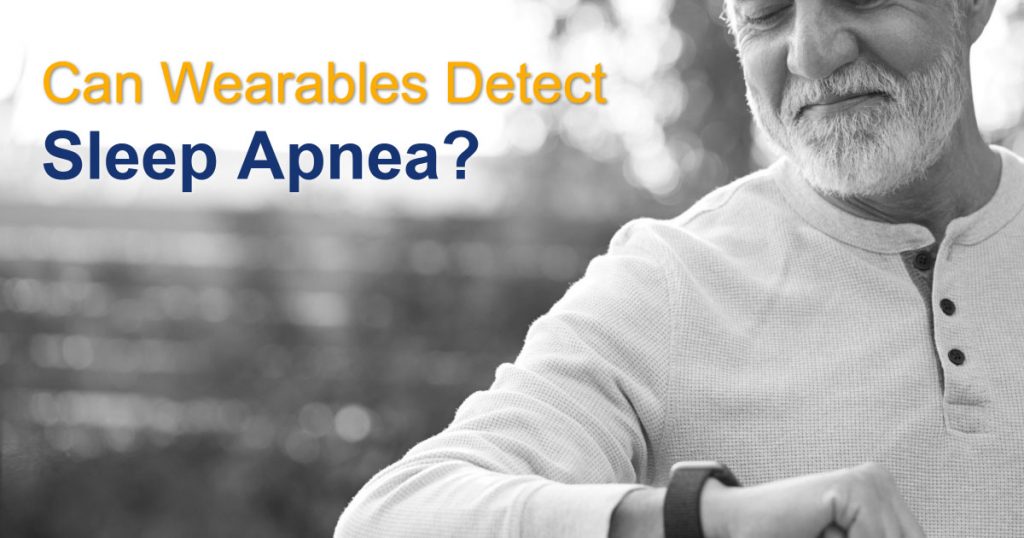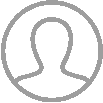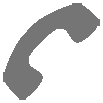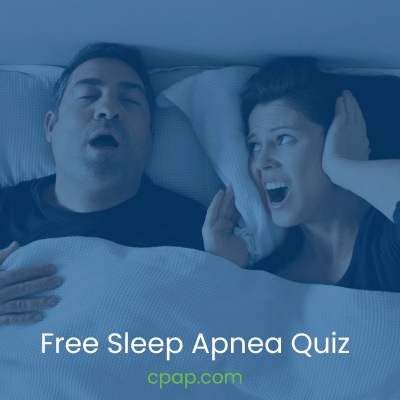
💡 Key Takeaways
- Smartwatches as Early Indicators: While not FDA-approved for diagnosis, smartwatches can track sleep quality and vital signs, serving as early indicators of sleep apnea.
- Variability in Features: Not all smartwatches are created equal; some offer advanced features like oxygen level tracking and snoring detection.
- Comparison with Home Sleep Apnea Tests: Smartwatches collect similar types of information as Home Sleep Apnea Tests (HSATs), although HSATs provide more detailed data.
- Brands Matter: Apple Watch, Garmin, and Fitbit offer various features that can help in detecting signs of sleep apnea.
- Consult a Healthcare Provider: Despite the capabilities of smartwatches, an official diagnosis requires a traditional sleep test or a Home Sleep Apnea Test from a healthcare provider.
Experts estimate that 80% of people with sleep apnea don’t even know they have it. One possible solution is using personal health trackers, such as smartwatches, to identify those who may be at risk. But how can a smartwatch detect sleep apnea, and are they effective? It turns out they are, but you have to know what you’re looking for and how to use these devices correctly.
In this article, we’ll discuss how:
- These devices play a role in sleep apnea detection.
- Smartwatches measure up to professional sleep apnea tests.
- Apple Watch, Garmin, Fitbit, and other devices alert you to the signs of sleep apnea.
- Sleep apnea-tracking apps maximize the potential of your smart devices.
Can a Smartwatch Detect Sleep Apnea?
While they cannot officially diagnose any condition, smartwatches can be used to track sleep apnea. Smartwatch technology is often used to track sleep quality and health status. This type of data helps people identify early warning signs.
Of course, not all wearables have the same capabilities. Some only track your physical movements, which may tell you if you are experiencing poor sleep quality, but not sleep apnea.
However, many newer devices– for example, the Apple Watch Series 6– have become so advanced that they can report important vital signs and health measurements, such as:
- Snoring
- Pulse
- Respiratory Rate
- Blood Oxygen Levels
- Heart Rhythm
- Sleep Stage
- Sleep Quality
While the FDA has not approved these devices for actually diagnosing sleep apnea, the health data that they provide offers a lot of insight into whether or not you are actively showing signs of sleep-disordered breathing.
Simply put, these smart health trackers report sleep apnea warning signs that tell you when it’s time to see a doctor.
Think You May Have Sleep Apnea? Take Our FREE Sleep Apnea Quiz!
How Do Smartwatches Track Sleep Apnea?
The beauty of using a smartwatch to detect signs of sleep apnea is that these devices are already designed to track your sleep patterns and vital signs. The technology piggybacks off of a form of sleep apnea testing that already exists– Home Sleep Apnea Tests (HSAT).
While smart devices can’t collect all the same health information as an official sleep apnea test, there is some overlap in their capabilities. These areas include:
- Sleep Patterns and Quality
- Cardiovascular Activity
- Oxygen Levels in Your Blood
- Body Positioning During Sleep
- Effort Needed to Breathe
- Airflow Into the Lungs
Comparing Health Trackers to Professional Sleep Apnea Testing
If your doctor suspects you have sleep apnea, they will order either a polysomnograph or an HSAT. To understand how your smartwatch or health tracker compares to these sleep apnea tests, let’s briefly go over the two main categories of sleep studies.
- Polysomnogram: Traditionally, people with sleep apnea would have to go through an overnight sleep study called a polysomnograph. These tests are usually a headache to schedule because they take place in a specialized sleep lab and require an overnight technician to be present.
- Home Sleep Apnea Test: An HSAT is an alternative to a polysomnogram. This sleep test is FDA-approved and is completed in the comfort of your own home. These home sleep tests report a lot of the same types of information that newer smartwatches are also capable of detecting.
To provide an accurate sleep apnea diagnosis, a Home Sleep Apnea Test must track your physical and sleep health in a variety of categories, referred to by the acronym SCOPER–
- Sleep
- Cardiovascular System
- Oxygen Saturation
- Body Position
- Respiratory Effort
- Airflow
Let’s take a look at how the newest smartwatches are capable of measuring health data from these same categories! Older models may share some of the more basic capabilities as well, such as heart rate and movement.
| SCOPER Category | Smartwatch/Device Capabilities | Sleep Apnea Signs to Watch For |
|---|---|---|
| Sleep | Newer smartwatches can track each stage of sleep, sleep quality, and total amount of time spent asleep. | Sleep apnea causes you to get less REM sleep, poorer overall quality of sleep, and fewer total hours of sleep. |
| Cardiovascular System | Most health trackers record heart rate. Newer models may even record your heart rhythm. | Your pulse will slow down during a sleep apnea episode and then speed up when it’s over. |
| Oxygen Saturation | A lot of smart devices will record your blood oxygen levels. | Severe sleep apnea episodes may cause your blood oxygen levels to fall. |
| Body Position | Health trackers usually record your body’s movements whenever you are wearing the device. | A sleep apnea event can startle you awake. You may also see an increase in your overall activity during sleep. |
| Respiratory Effort | Some smart devices are able to measure your breathing rate. | Sleep apnea may cause you to breathe more slowly than normal. |
| Airflow | Some devices can detect snoring, which indicates an airway blockage. | One common sign of Obstructive Sleep Apnea is regular, loud snoring. |
(S) Sleep
People with sleep apnea get fewer hours of sleep and spend less time in deep sleep. Some smartwatches track your sleep quality, including the number of hours spent in each stage of sleep. If you aren’t getting good quality sleep, you may have sleep apnea.
(C) Cardiovascular System
When you have a significant sleep apnea episode, your heartbeat will temporarily slow down before abruptly speeding up as soon as you resume normal breathing. Most smartwatches can determine your heart rate and, in some cases, may even be able to report your actual cardiac rhythm. If you see your heart rate changing a lot, it could be a sign of sleep apnea.
(O) Oxygen Saturation
Many of the newest smartwatches have the ability to track your blood oxygen levels. If your oxygen levels temporarily fall and then recover during sleep, it may be a sign that you are experiencing periods of slow or even no breathing due to sleep apnea.
(P) Body Position
People with sleep apnea tend to move more often during sleep. In some cases, this is because they wake up gasping for air. In others, they are experiencing an abnormal increase in Periodic Limb Movements as they sleep. Just as your typical fitness tracker is able to determine when you’re on the move, most smartwatches are designed to detect when you move around at night during sleep.
(E) Respiratory Effort
Obviously, sleep apnea impacts your breathing in many ways. People with Obstructive Sleep Apnea often have to work harder to breathe while they are asleep because their airway is partially or totally blocked. Some smartwatch devices offer the ability to track your respiratory rate by measuring your chest movements while you sleep.
(R) Airflow
“Airflow” essentially refers to how difficult it is for air to flow into your lungs. When you have sleep apnea, you have a high amount of airway resistance due to airway obstruction. While wearable devices cannot tell you exactly how much resistance you are experiencing, many of them can help detect snoring, which is a sign of Obstructive Sleep Apnea.
Which Smart Devices Detect Sleep Apnea?
The following smart devices cannot replace an actual sleep study. Therefore, they cannot definitively tell you whether or not you have sleep apnea. Health tracking can only tell you whether or not you are experiencing some of the signs of sleep apnea, particularly OSA.
Can Apple Watch Detect Sleep Apnea?
Newer Apple Watches track a range of health information that can be used to detect sleep apnea. A 2017 study from UCSF found that the Apple Watch could accurately detect sleep apnea with 90% accuracy when paired with the Cardiogram app.
While a doctor can only officially diagnose sleep apnea, the new Apple Watch (releasing 2024) will include a specialized sleep apnea feature that will alert you if you show signs of sleep apnea. Older Apple Watches can still track common signs of sleep apnea, such as snoring, heart rate changes, and sleep disturbances.
Here are some of the data points that the Apple Watch is capable of tracking!
- Heart Rate
- Heart Rhythm (ECG)
- Blood Oxygen Levels
- Physical Movements
- Sleep Stages
- Respiratory Rate
- Number of Hours Spent Asleep
- Detects Loud Snoring (When Paired With Outside Apps)
Can Garmin Detect Sleep Apnea?
Like most new-generation smartwatches, Garmin is capable of tracking your sleep health. This includes reporting information that alerts you to sleep apnea. This data can be accessed via the Advanced Sleep Monitoring feature on Garmin Connect.
Garmin’s sleep apnea tracking features are very similar to the Apple Watch and include the following:
- Heart Rate
- Heart Rhythm (With the Venu 2 Plus)
- Blood Oxygen Levels
- Physical Movements
- Sleep Stages
- Respiratory Rate
- Number of Hours Spent Asleep
- Detects Loud Snoring (When Paired With Outside Apps)
For a list of Garmin watches that are compatible with the Advanced Sleep Monitoring feature, check here!
Can Fitbit Detect Sleep Apnea?
Newer Fitbit watches are capable of detecting sleep apnea! While it cannot be used to officially diagnose sleep-disordered breathing, the newest oxygen sensor feature makes Fitbit a useful tool for alerting you to potential warning signs of sleep apnea.
Below is a list of the information that Fitbit tracks that can be used to identify possible cases of sleep apnea!
- Heart Rate
- Heart Rhythm
- Blood Oxygen Levels
- Physical Movements
- Sleep Stages
- Respiratory Rate
- Number of Hours Spent Asleep
- Snoring
Can Oura Ring Detect Sleep Apnea?
Although it cannot officially diagnose any condition, the Oura Ring offers several features that make it perfect for keeping you informed on changes to your sleep health, including detecting signs of sleep apnea.
The Oura Ring offers the following sleep apnea-related functions:
- Heart Rate
- Blood Oxygen Levels
- Physical Movements
- Sleep Stages
- Respiratory Rate
- Number of Hours Spent Asleep
Can SleepHQ O2 Ring Detect Sleep Apnea?
The SleepHQ O2 ring is a simple device that offers basic health tracking. When used with the SleepO2, this device shows trends and alerts you to concerning patterns. It does not have as many features as an Apple Watch, Garmin, or Fitbit. However, it can be used to track:
- Heart Rate
- Blood Oxygen Levels
- Physical Movements
Best Apps for Tracking Sleep Apnea
Third-party apps enhance smartwatch sleep apnea detection and, in some cases, may even be able to detect signs of sleep apnea without the help of a smart device. Many of these apps are designed to measure specific aspects of sleep health and sleep apnea, such as:
- Snoring
- Sleep Patterns
- Cardiovascular Activity
- Breathing Patterns
Check the Science!
Research suggests that these smartphone apps can be quite accurate when identifying the signs of sleep apnea. A 2015 study found that the Android app ApneaApp was able to accurately detect sleep apnea events 98% of the time by measuring participants’ breathing movements throughout the night.
There are several reputable sleep-tracking apps available for both iPhone and Android platforms, such as:
- SleepTracker-AI: Monitors heart rate, breathing changes, and nighttime movements.
- SnoreLab: Great for tracking snoring.
- Sleep as Android: Tracks your sleep cycle and heart rate and detects snoring.
To learn more about using apps to detect sleep apnea signs, check out our guide to the best sleep apnea apps!
FAQs About Using Smartwatches to Diagnose Sleep Apnea
What Apps Detect Obstructive Sleep Apnea?
There are many sleep-tracking apps available on iPhone and Android platforms, such as SleepTracker 24/7 and SnoreLab. These apps provide insight into your sleep health, which may alert you to the signs of sleep apnea.
Is There a Watch That Monitors Sleep Apnea?
Many wearable devices are equipped with advanced sensors that can track sleep stages, oxygen saturation levels, and heart rate, but none are FDA-approved to detect or diagnose sleep apnea. At best, the data collected by these devices may indicate that further sleep testing is needed.
Can a Smartwatch Tell if You Have Sleep Apnea?
Smartwatches and fitness trackers collect an impressive amount of health and wellness data, much of which can be used to identify certain sleep-breathing patterns that are associated with sleep apnea. However, these devices are not FDA-approved to provide an official diagnosis.
What Is the Best Smartwatch for Sleep Apnea?
There are several great smartwatches that can detect signs of sleep apnea, such as the Apple Watch, Garmin, and Fitbit. These devices offer similar features, including the ability to track blood oxygen levels, sleep stages, heart rate, and breathing rate.
Will My Doctor Put Me On CPAP if My Apple Watch Says I Have Sleep Apnea?
Apple Watches cannot officially diagnose you with sleep apnea, but they can tell you if you are exhibiting signs of this sleep disorder. If you are concerned that you may have sleep apnea and need a CPAP machine, it is best to see your healthcare provider, who can order a diagnostic sleep test.
How Is Sleep Apnea Diagnosed?
An official sleep apnea diagnosis must be made with a polysomnogram or a Home Sleep Apnea Test. In order to qualify for a mild sleep apnea diagnosis, you must experience at least five apnea episodes per hour of sleep.
Final Thoughts
So, to recap– can smartwatches detect sleep apnea? Yes, but they can’t be used to give you an official diagnosis. Smartwatches and fitness devices are great for identifying the signs of sleep apnea so that you know when it’s time to speak to your doctor.
If you suspect you have sleep apnea or any other sleep disorder, you should speak with your healthcare provider about actual diagnostic testing via a sleep study. If you’re considering using a smart device to track your sleep apnea, we suggest using an Apple Watch, Garmin, or Fitbit!





7 Responses
Thanks, this is helpful info, I’m trying to figure out which wearable to buy to make an initial assessment – I can’t afford the full sleep study thing and hopefully I won’t need it.
Hi Michigan, we are glad that you found the article helpful. If we can be of any further assistance, please feel free to reach us at: 1-800-356-5221, or you may e-mail us at: cpap@cpap.com.
Have a great day!
My Fitbit Alta HR records the number of times I wake up during the night. Since that number is under 30, can I assume that I don’t have apnea? Or does the Fitbit not record every time I stop breathing as a time awake? I am often tired.
Hey Katherine, my apologies, but we don’t sell the Fitbit therefore, we don’t have information as to what the reading equates to. Please speak with your doctor to confirm if your Sleep Apnea diagnosis is still relevant. Also, I would recommend you letting your doctor know that you are still feeling tired, they may want to adjust some of the settings on your CPAP machine.
Please feel free to reach us at: 1-800-356-5221.
Enjoy your evening!
Can you please rank the wearables as the best for sleep apnea monitoring. I use Android. I heard Fitbit charge 3 was good. Which one watch would you buy your love one? I’m disabled so money is tight and I want to get the best one once not return because another was better. I know Fitbit charge 3 are awaiting fda approval.
Hey Alex, i’m sure there are many different wearable options to track your CPAP therapy. CPAP.com, only have 2 available. Please see the links below for the options we carry. The links aren’t listed in any particular order, as they are both pretty new to our company.
https://www.cpap.com/productpage/garmin-vivosmart-4-activity-tracker
https://www.cpap.com/productpage/polar-pro-a370-fitness-tracker
If you think of any questions, or concerns, please feel free to reach us at: 1-800-356-5221, or you may e-mail us at: cpap@cpap.com.
Have a wonderful weekend!
With the release of Apple Watch Series 6, which has a built-in Blood Oxygen sensor, this could tie in very well with the sleep tracker function introduced in WatchOS 7. Based on your Article, have blood oxygen measured whilst asleep will increase accuracy of detecting sleep apnea > care to share some light on this?